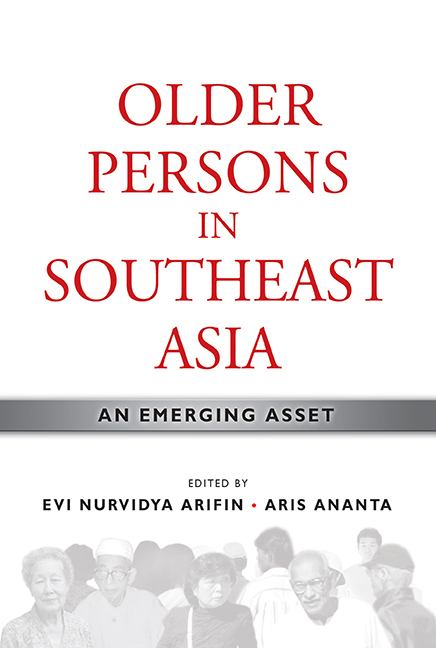Book contents
- Frontmatter
- Contents
- List of Tables
- List of Figures
- Foreword by Hal Hill
- Message from the Director
- Preface
- Contributors
- PART I INTRODUCTION
- PART II OLD-AGE INCOME SECURITY
- PART III EMPLOYMENT AND OTHER SOURCES OF FINANCIAL CONTRIBUTION
- PART IV AGEING, MIGRATION, AND DEVELOPMENT
- PART V ROLES OF GOVERNMENT AND CIVIL SOCIETY
- Index
Foreword by Hal Hill
Published online by Cambridge University Press: 21 October 2015
- Frontmatter
- Contents
- List of Tables
- List of Figures
- Foreword by Hal Hill
- Message from the Director
- Preface
- Contributors
- PART I INTRODUCTION
- PART II OLD-AGE INCOME SECURITY
- PART III EMPLOYMENT AND OTHER SOURCES OF FINANCIAL CONTRIBUTION
- PART IV AGEING, MIGRATION, AND DEVELOPMENT
- PART V ROLES OF GOVERNMENT AND CIVIL SOCIETY
- Index
Summary
The editors and contributors to this volume are to be congratulated for a topical, fascinating and broad-ranging study of ageing in Southeast Asia. The authors raise many thought-provoking, indeed worrying, issues. But the subtitle could just as well have been something like “the challenge of success”, for one of the key drivers of Southeast Asia' dramatic demographic transitions has of course been the region' rapid socioeconomic development.
The study deepens our knowledge of demographic issues in the ten countries and, more broadly, it connects to at least four sets of analytical and policy issues. The first is the speed of the region' demographic transitions in recent decades. For a volume on ageing, it is useful to remind younger readers that the literature up to the 1970s was preoccupied with rapid population growth, and its associated challenges — providing employment, education and housing. Malthusian scenarios were ever-present in some countries, memorable for example in the arresting observation of Nathan Keyfitz that the island of Java was in danger of “asphyxiating for want of land”.
A decade into the twenty-first century, not only are population growth rates falling, but in some countries populations are actually declining, or at least they would if it were not for net in-migration. In Asia, Japan is leading the way in this respect, with Singapore and China following closely. Korea and parts of Southeast Asia are likely to be in this situation within a decade. As the editors observe, countries are becoming “old before they are rich”, which is contrary to the demographic experience of Western countries, with the wealth to more easily manage the economic challenges associated with ageing.
In Southeast Asia, the Singapore experience illustrates the rapidity of demographic change. As David Reisman points out, Singapore' infant mortality rate has declined from 82 (per thousand live births) in 1950 to 2.6 in 2007, one of the lowest in the world. Correspondingly, its fertility rate has also fallen dramatically, from about 6.4 in 1950 to 1.3 in 2007. As a result, the “dependency ratio” (somewhat arbitrarily defined as the population aged under 15 and 65+ years, as a percentage of the working age population 15–64 years) at first fell sharply, from about 95 per cent in 1966 to 39 per cent in 2006.
- Type
- Chapter
- Information
- Older Persons in Southeast AsiaAn Emerging Asset, pp. xix - xxivPublisher: ISEAS–Yusof Ishak InstitutePrint publication year: 2009

